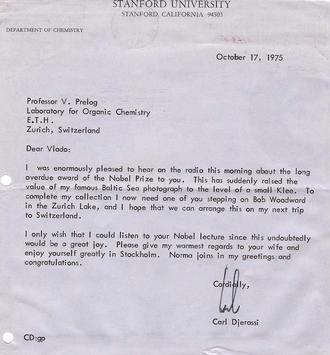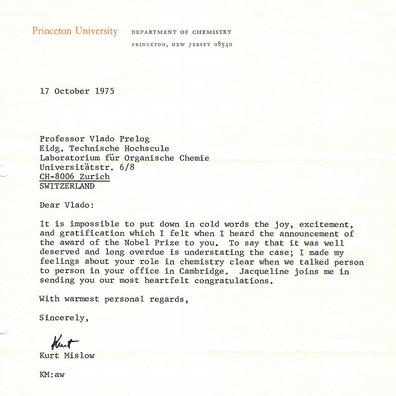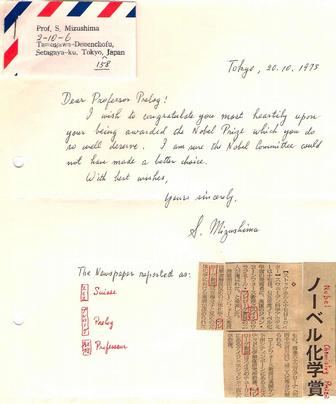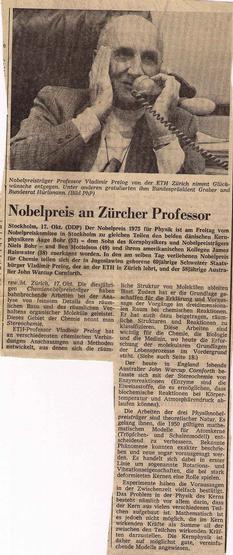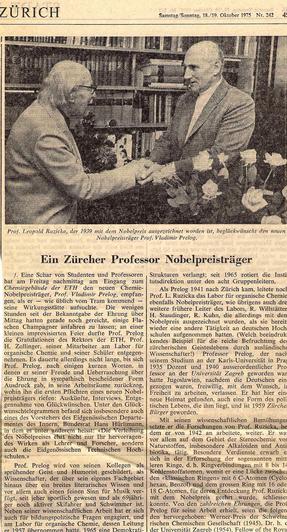Vladimir Prelog - Nobel Prize
Press Release
17 October 1975 - external pageThe Royal Swedish Academy of Sciencescall_made has decided to award the 1975 Nobel Prize in Chemistry with one half to Professor John Warcup Cornforth, England, for his work on the stereochemistry of enzyme-catalyzed reactions and with the other half to Professor Vladimir Prelog, Switzerland, for his research into the stereochemistry of organic molecules and reactions.
Cornforth has been awarded the Prize for his work on the stereochemistry of enzyme-catalyzed reactions. This subject is difficult to explain to the layman as it is a question of geometry in three dimensions; it is concerned with the delicate mechanism of important reactions in biological systems, where a group of atoms takes the place of a certain hydrogen atom among two or three, which may appear to be equivalent. The problem is to decide which of the hydrogen atoms is replaced and if nearby groups retain their positions or if they are rearranged in some way. The enzyme leads the process in a quite uniform way. Without this guidance, chaos would break out in the biological system. Cornforth "marks" the hydrogen atoms by making use of hydrogen's three isotopes; ordinary hydrogen (mass 1), heavy hydrogen or deuterium (mass 2) and radioactive hydrogen or tritium (mass 3). He then makes use of their differing reaction speeds (the lightest reacts the quickest). Only trace quantities of tritium can be used; no more than a millionth or so of the molecules involved in the reaction are marked. The planning of this research is an outstanding intellectual achievement. Among the biologically significant reactions the stereochemistry of which has been clarified is the synthesis of steroids from mevalonic acid via squalene and the condensations of acetate with glyoxylic acid to malic acid and with oxalylacetic acid to citric acid. Since Cornforth has shown the way similar research has been initiated in other quarters.
The Prize has been awarded to Professor Prelog for his research into the stereochemistry of organic molecules and reactions, i.e. the connection between the course of chemical reactions and the geometric form of the participating molecules. His research spans a wide field. One area of study has been "medium-sized rings" - ring-shaped molecules with 8-12 carbon atoms. A ring of this kind is fairly mobile one might almost say "flaccid"'; apparently remote parts of the molecule can come into close contact with each other thus causing unexpected reactions. Medium-sized rings are not unusual in nature. Another important area of his research is that concerned with chiral molecules, formerly called asymmetric molecules. The word "chiral" comes from the Greek meaning "hand" and signifies that the molecules can have two forms differing from one another as the right hand does from the left. Prelog has done very significant research on reactions between chiral molecules. This research is of fundamental importance to an understanding of biological processes. Prelog has also led a very penetrating discussion of the conditions governing chirality in complex molecules. Prelog has experimented with enzymes acting on simple molecules, where the result depends on how the compound and the enzyme "suit one another". Systematic experiments with simple compounds of well-defined structures give valuable information about the structure of enzymes and the way they act.
It should perhaps be mentioned that Professor Prelog has also done extensive research on special groups of natural products, e.g. alkaloids and antibiotics from microorganisms, where his profound knowledge of stereochemistry has been of great advantage.
Copyright © The Nobel Foundation 1975
Presentation Speech by Professor Arne Fredga of the Royal Academy of Sciences
Translation from the Swedish text (in English and German)
Your Majesties, Your Royal Highnesses, Ladies and Gentlemen
The laureates in chemistry of this year have both studied reaction mechanisms, especially from a stereochemical, i.e. a geometrical point of view. In a chemical experiment some compounds are mixed, then something happens, and finally one can isolate one or more other compounds. What has really happened, and why, and how? The situation is as if someone had abbreviated a classical tragedy, say Hamlet, by showing only the opening scenes of the play and the final scene of the last act. The principal characters are introduced, then the scene closes and when the curtain rises again you see a number of dead bodies on the stage and a few survivors. Of course the spectators would like to know what has happened in the meantime.
What I have said is valid not least for enzymatic reactions. Many such reactions are perpetually going on in all living organisms; one could say that they really concern all of us although we don't observe them. When a chemist tries to find out what really happens, he often comes across the problem: right or left? It is the same in common life. If you leave Stockholm by Norrtull, you soon come to a place where the main road branches: the left branch leads to Oslo, the right one to Sundsvall or, if you like, to Haparanda.
Professor Cornforth has among other things studied the biological synthesis of the hydrocarbon squalene from six molecules of mevalonic acid. This hydrocarbon is necessary for the formation of steroids, which are of vital importance in many respects. The synthesis of squalene takes place in 14 steps and at each the enzyme must find the proper way. That means that there are just 214 = 16384 different routes and only one of them leads to squalene. If the enzyme should make a mistake in the first step (which it does not), the final result could be rubber or various other things but definitely not squalene. The problem at each step concerns which of two hydrogen atoms is to be eliminated, the right one or the left one. Professor Cornforth has shown which choice the enzyme makes at each of the 14 steps. For this purpose he has, with brilliant mastership, utilized the properties of the hydrogen isotopes: the ordinary hydrogen, the heavy hydrogen and the radioactive hydrogen. The last mentioned isotope can only be used in tracer quantities, which means that only about one part per million of the participating molecules are radioactive. In a similar way, Professor Cornforth has studied several other biologically important reactions. All problems connected with the reaction mechanisms are not solved at that point, but the results constitute a very important step on the way.
Professor Prelog has worked in many fields of stereochemistry, and often the problems have been connected with the geometrical shapes of the molecules and their influence on the course of the reactions.
An impressive series of investigations deal with the "medium rings", i.e. molecules containing rings of 8 to 11 carbon atoms. Such rings are not rigid but rather limp. Parts of the ring which may seem rather distant may come into close contact with each other leading to unexpected reactions. Professor Prelog has been able to elucidate such reactions by utilizing the carbon isotopes.
Many important investigations refer to reactions between chiral molecules. The term chiral is derived from a word in ancient Greek, meaning hand. The molecules are unsymmetrical and may exist in two forms differing in the same way as a right hand and a left hand. The molecules are so small that you can't see them, but one can gain much knowledge by studying the reactions between chiral molecules of different kind.
Professor Prelog has also made important contributions to enzyme chemistry. He has studied enzymatic reactions on small molecules and in particular oxidation or reduction processes. The experiments may be more or less successful depending on how the enzyme and the other molecule fit together geometrically. By systematic experiments with various small molecules of well-defined shapes, it was possible to construct a "map" of the active part of the enzyme molecule. The results have recently been confirmed in a special case by Swedish scientists using x-ray methods.
Professor Prelog has also with ingenuity and penetration discussed and analyzed the fundamental concepts of stereochemistry, not least the conditions for chirality in large and complicated molecules.
Professor Cornforth. Enzymatic reactions have always had a certain air of magic, perhaps witchcraft. Of course this is due to our imperfect knowledge of what really happens. This air of magic is, however, gradually dispersing, and your contributions, utilizing the isotopes of hydrogen, imply most striking advances. The handling of compounds with chiral methyl groups is an
achievement of the highest intellectual standard.
Let me also express our admiration for the skill and perseverance with which you have pursued your work in spite of a serious physical handicap. Perhaps it had not been possible without the never-failing help and support of Mrs. Cornforth. I think she should not be forgotten on this day. In recognition of your services to chemistry and to natural science as a whole, the Royal Academy of Sciences has decided to confer upon you the Nobel Prize. To me has been granted the privilege to convey to you the most heartly congratulations of the Academy.
Professor Prelog. Ich habe hier versucht, einen Kurzbericht über Ihre wichtigsten Leistungen in der Stereochemie zu erstatten. Das war gewiss etwas schwierig. Ihre schönen Experimentalarbeiten erstrecken sich über weite Felder der heutigen organischen Chemie. Öfters haben Sie die Fortführung Ihrer Arbeiten anderen Forschern überlassen, und viele Chemiker hohen Ranges sind zurzeit auf den Gebieten tätig, die Sie einst eröffnet haben. Sie haben auch die fundamentalen Grundlagen der Stereochemie, besonders den Chiralitätsbegriff, in tiefsinnigen Auseinandersetzungen diskutiert und klargelegt.
In Anerkennung Ihrer Verdienste um die Entwicklung der Chemie hat die Königliche Akademie der Wissenschaften entschlossen, Ihnen den Nobelpreis zu verleihen. Mir ist die Aufgabe zugefallen, Ihnen die wärmsten Glückwünsche der Akademie zu überbringen.
Professor Cornforth. In the name of the Academy, I invite you to receive your Prize from the hands of His Majesty the King.
Professor Prelog, Im Namen der Akademie bitte ich Sie aus den Händen Seiner Majestät des Königs den Nobelpreis in Empfang zu nehmen.
From external pageNobel Lecturescall_made, Chemistry 1971-1980, Editor-in-Charge Tore Frängsmyr, Editor Sture Forsén, World Scientific Publishing Co., Singapore, 1993
Copyright © The Nobel Foundation 1975

